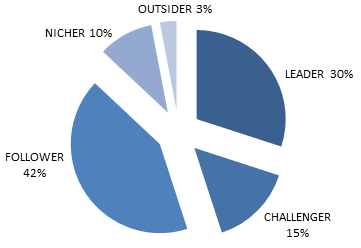An offerer has five possible positions related to his competitors: leader, challenger, follower, nicher, and outsider.
The following figure illustrates the market shares—only hypothetical, as they vary greatly depending on the markets and products taken as a reference—of each positioning.

The leader is the supplier with the largest market share. For this reason, he is the principal role model, permanently imitated and harassed by his competitors.
To maintain his position, the leader must exercise broad and intense marketing efforts, staying ahead of the constant changes. This stance includes innovation in the product line, distribution, sales, pricing, financing, communication, and promotion of his offers.
The challenger is the competitor who, with a relevant operational base, seeks to snatch significant portions of the market from the leader or even displace him from leadership. For that, he must also develop competitive advantages that attract and ensure customers’ preference for his offers.
The follower is the competitor who, neither a leader nor a challenger, is satisfied to imitate the most successful players in their market. His advantage is that he can use his competitors as benchmarks without assuming the burden of investing in pioneering technologies, an unprecedented modus operandi, or the costs of exploring an incipient market.
In turn, the nicher, or occupant of a market niche, is the competitor who specializes in meeting some specific needs that are poorly or not at all met by others. Thus, he does not compete directly with the leader, the challenger, and the followers.
For example, the orchid provider serves a particular group of customers (orchid growers, interior decorators, and landscapers) whose potential demand is limited but compensated by the buyer’s loyalty and the generous prices he can charge.
Finally, the outsider is the competitor whose offer may or may not differ from that set by the leader, questioned by the challenger, imitated by followers, or adopted by the niche occupant. This competitor, lining up alongside, can be a privileged, a corruptor, or just an eccentric. However, instead of imitating and developing improvements that support the established standard, he can be an innovator who invests in disruptive technologies and latent needs that, when successful, define a new supply pattern and create a new market.
Concerning that positioning, Clayton Christensen, in The Innovation Dilemma, describes the work of some American outsiders in hard drives and flash memory, excavators, and mini steel plants.
C. L. Eckhard, author of Pricing in Agribusiness: setting and managing prices for better sales margins.











 Claudio Luiz Eckhard is a former professor, business consultant, and author of the books “Ajustando o Rumo”[Adjusting the Business Course], “Gestão pela Margem”[Management by Margin], “A Empresa Saudável”[The Healthy Company], and “Pricing no Agribusiness”[Pricing in Agribusiness].
Claudio Luiz Eckhard is a former professor, business consultant, and author of the books “Ajustando o Rumo”[Adjusting the Business Course], “Gestão pela Margem”[Management by Margin], “A Empresa Saudável”[The Healthy Company], and “Pricing no Agribusiness”[Pricing in Agribusiness].


